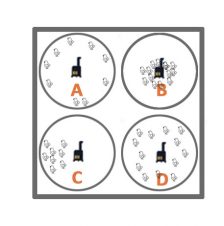The comfort of your chickens is important!
Practical tips for successuful breeding
This program is offered for a breeding of 100 chicks.
LOCAL
- Select a well-ventilated area, without drafts, with adequate ventilation, and protected from rodents or any other nuisances.
- Clean and disinfect the space, the feeders, and the drinkers.
- Heat the space to provide a moisture-free environment for your chicks upon their arrival.
- Spread a 15 to 20 cm (6 to 8 inches) layer of straw or wood shavings on the floor to:
– Absorb moisture
– Reduce ammonia emissions
– Minimize the presence of flies
– Prevent injuries
Apply drying powder to eliminate moisture from the bedding. - Regularly remove droppings and wet litter to prevent diseases.
- Add fresh bedding as needed.
LIGHTING
Duration: | 23 hours of light per day. |
Intensity: | A 25 to 40 watt bulb per 40 square feet. |
Arrangement: | Above the feeder and the drinker. |
EQUIPEMENTS
Install at the center of the space:
- A heat lamp at 46 cm (18 inches) from the ground.
- Two feeders where the chicks will have feed available at all times.
- A 1-gallon drinker for every 50 chicks.
IMPORTANT: for the first few days, fill the drinkers with warm water.
Create a comfort zone.
Surrond the euipment with corrugated cardboard 30 to 40 cm (12 à 15 ½ inches) high and with a diameter of 1,2 meters (4 feet).
As the chicks grow and thrive:
1. Expand the comfort zone.
Required space for breeding in sqare feet
Age, weeks
0-6
7 to 10
11 to 20
21 and more
Floor
1/2
1
1 1/2 to 2
2 1/2 and more
2. Ajust the height of the drinkers and feeders so that they are level with the birds' backs. Clean the drinkers and feeders daily.
ALIMENTATION
For the first 2 or 3 weeks, serve Starter feed (VG or OM).
Afterward, serve Grower Feed (VG or OM).
Consumption
Age, day
0-15
16-29
30-42
43-60
60-70
Male (cumulative)
321 g
870 g
1.85 kg
3.34 kg
2.14 kg
Female (cumulative)
309 g
870 g
1.52 kg
1.90 kg
3.09 kg
Weeks to reach the target weight
Chicken of
2 to 3 kg
4 to 5 kg
More than 5 kg
To be slaughtered at
3 to 4 weeks
7 to 9 weeks
12 weeks
The feed must be available at all times.
Do not serve whole grains before the age of 6 weeks.
CALCULATOR
TEMPERATURE
Chicks require a lot of heat in the first few weeks.
- 32° to 35° C (90° to 95° F)
- Gradually lower the temperature by 5° C (41 ° F) per week.
- Until reaching 21° C (70° F)
Using a Mix-Max thermometer can be very helpful for monitoring the temperature.
Are your chicks comfortable?
A Too hot
B Too cold
C Too drafty
D Ideal

Temperture chart
Heat source temperature
Consumption
Age, day
1-7
8-14
15-21
22-28
29-35
36 up to market
Summer
32°C (90°F)
29.5°C (85°F)
26°C (80°F)
23.5°C (75°F)
21°C (70°F)
21°C (70°F)
Winter
35°C (95°F)
32°C (90°F)
29.5°C (85°F)
26°C (80°F)
23.5°C (75°F)
21°C (70°F)
PETITS CONSEILS
- Acheter des poussins en santé.
- Les premiers jours de leur arrivée, visiter fréquemment les oiseaux, afin de stimuler leur consommation de moulée
- Surveiller les symptômes comme la toux, yeux larmoyants, respiration difficile, déjection liquide ou baisse importante de la consommation.
- Ne pas utiliser de perchoirs ou de nids pour les poulets de chair car ceci peut causer des blessures à la poitrine et aux pattes.
- Plus l'oiseau devient âgé et lourd, moins il est efficace et il consomme alors plus de moulée…